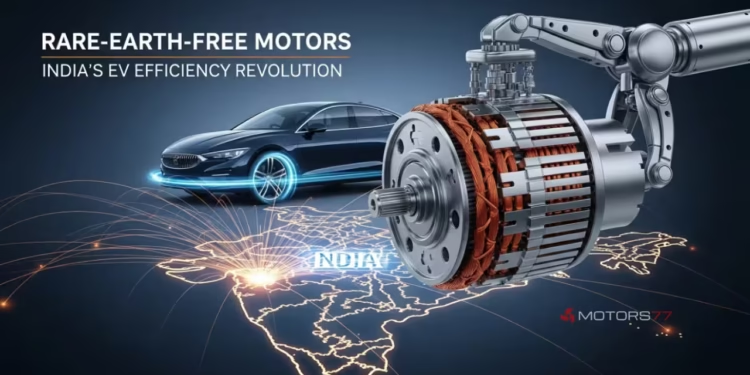In the fast-evolving world of electric vehicles (EVs), sustainability and efficiency aren’t just buzzwords they’re the keys to unlocking a greener, affordable mobility future. But the industry has long been dependent on rare-earth elements like neodymium and dysprosium to build high-performance EV motors. This reliance comes at a steep cost environmental damage from mining, price volatility, and heavy dependence on China, which controls over 80% of the global supply.
Now, a wave of innovation, both global and local is reshaping the landscape. While San Francisco based Conifer Motors has just raised $20 million to scale its rare-earth-free axial flux motors, India too has stepped onto the front lines, testing and piloting rare-earth-free motor technologies that could redefine supply chain resilience and make EVs more affordable for millions.
The Rare-Earth free motors Dilemma
Permanent magnet motors have powered the EV revolution so far thanks to their compact size, high torque, and efficiency. But the extraction of rare earths is anything but clean producing toxic waste, guzzling water, and emitting significant CO₂.
With China tightening export curbs in April 2025, Indian automakers have been hit particularly hard. Imports account for nearly 90% of India’s rare-earth needs, and supply disruptions have already delayed launches for companies like Maruti Suzuki and JSW MG Motor. This has made alternatives no longer optional, but urgent.
Global Breakthroughs: Conifer Motors’ $20M Spark
Founded in 2023 by ex-Tesla engineers, Conifer has developed axial flux motors powered by ferrite based magnets instead of rare earths. Early tests show efficiency of up to 98% around 5% better than today’s permanent magnet motors and higher torque density. More importantly, ferrite composites remain stable even at 200°C, making them ideal for heavy-duty EVs.
Backed by leading global investors, Conifer is targeting commercial rollout by late 2025. For global EV makers, this could cut motor costs by 30%, strengthen supply chains, and make EVs cheaper worldwide.
India’s Homegrown Push: From Startups to OEMs
While Conifer grabs global headlines, India is quietly becoming a hub for rare-earth-free motor R&D.
- Chara Technologies (Bengaluru): Building synchronous reluctance motors with ferrite magnets, already supplying over 30 OEMs in the two and three-wheeler space.
- Sterling Gtake E-Mobility (Faridabad): Partnering with UK based Advanced Electric Machines to test magnet-free motors, with evaluation underway at seven major Indian automakers.
- Government Support: The Production Linked Incentive (PLI) scheme has attracted over $9 billion into domestic EV and component manufacturing, including incentives for non-rare-earth powertrains.
This ecosystem means India isn’t just a follower—it’s fast becoming a test bed for global EV motor innovation.
India Tests Rare-Earth-Free EV Motors: Can They Solve the Supply Chain Crunch?
The Ministry of Heavy Industries is backing pilot projects for rare-earth-free motors, with collaborations between Indian startups, PSU research labs, and global partners. The target: reduce dependence on Chinese imports and scale indigenous ferrite and reluctance motor production within three years.
For automakers like Tata Motors, Mahindra, and Ola Electric, such technology could be game-changing. Imagine a Tata Nexon EV with a ferrite-based motor production costs could drop by around ₹1–1.2 lakh per unit, while efficiency gains could add 10–15 km of extra range per charge. For India’s price-sensitive market, that’s the difference between niche adoption and mass market breakthrough.
Performance Gains Without the Price Tag
Rare-earth-free motors don’t just solve supply issues; they bring tangible benefits:
- 25% more torque density with axial flux architecture
- Lower cooling needs, translating to longer range per charge
- Durability up to 500,000 km, thanks to no rare-earth degradation
For India, these numbers matter. With EV penetration at 7.8% across categories in FY2025, affordable, durable powertrains are key to achieving the 30% adoption target by 2030.
The Road Ahead: Self-Reliance Meets Sustainability
India’s EV journey is no longer just about batteries or charging stations. Motors the beating heart of EVs are now central to the country’s self-reliance and green mobility mission. With global innovators like Conifer pushing boundaries, and Indian startups proving their mettle, the future looks promising.
For Motors77 readers, the takeaway is clear: rare-earth-free motors are no longer a lab experiment they’re the next big shift in EV technology. And India is not just catching up; it’s gearing up to lead.
Motors77 Take: Rare-earth-free EV motors could define the next decade of mobility in India. By cutting costs, boosting efficiency, and breaking supply chain shackles, they hold the key to mass adoption. The big question now: which Indian automaker will be the first to bring one to market?










